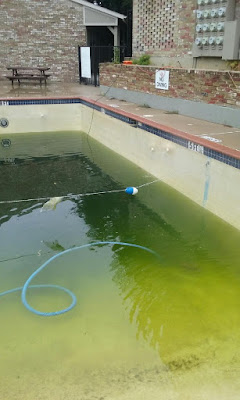The system and plumbing:
Ice and plumbing don’t mix. Most plumbing on pools now a days is made of PVC plastic and is subject to cracking as the water expands as it turns to ice. This can cause major damage in the lines for the returns and suction side of your system. Most inground pool plumbing is under ground and the depth it is buried depends on the frost line in your area (see chart below).

 Plumbing depth differs due to frost lines in your area
Plumbing depth differs due to frost lines in your area
The last thing you want is to have a freeze break in the plumbing under the nice concrete deck around your pool. This will cost a lot of money to replace and matching an old deck with a patch is hard to do. It can also be difficult to locate the exact point to start digging. And tunneling under the deck? Ugh - been there, done that!
What’s worse than that is an inground plastic skimmer that is sunk in concrete and rebar on all sides. The only way to fix them is to jack hammer it out and that takes about a day because the concrete is about a foot thick on all sides and you have to cut through rebar. Normal cost to replace a skimmer is about $1200 to $1700, so it is not something you want to have happen.
Your pool equipment is the “heart of you pool” as we call it, and it can become damaged too. We have seen pumps and filters freeze and split in half. When this happens you are better off buying a whole new filter. This is because most manufactures charge just as much for a filter tank as a whole new filter.
Pool heaters are a whole different game. They have 3 things that can be damaged from ice:
1. The exchanger, this is the most expensive part in the heater and can run as much as $1400 to replace. This is the copper tubing that is use to transfer heat from the flame to the pool water.
2. The headers, these are cast iron or high tempeture composite material at the ends of the exchanger that redirect the water flow to the pool and back to the exchanger. A low spot in the heater, the headers will freeze before anything else usually.
3. The pressure switch tube. This is a tube that water gets pushed through and operates a switch that tells the heater that there is enough water flow to operate the heater. It is only a 3/8th inch copper tube that is very prone to freezing.
The pool shell:
Pools come in all types of materials from Fiberglass, concrete, to metal or composite liners pools. All pools are made for all climates when it comes to the structure to a point. If the weather gets to freezing they must have the water lowered. The reason for that is the ice expands and if it start to push on the side at the top that can cause damage from popping off tiles and cracking the bond beam behind them to breaking the top rail supports on an above ground pool. It is best to plan ahead to winterize your pool before this happens.


Above ground pool freeze damage Inground pool tile and bond beam damage
So what can I do to prevent this?
The best thing to do is to winterize your pool before you get a freeze but when a freeze will hit is up to Mother Nature and you may not have time to do so.
What do you do if you know it is going to freeze? It is a fact that moving water has less of a chance to freeze. Take off your timer trippers if you have a timer or turn on your switch to set the pool to run 24 hours a day. The water flowing through your pipes will help protect your plumbing and system. If you have a heater, set it to the lowest setting to heat your pool. This will stop the surface of the water from freezing against your pool shell or tiles.
The good news is that they have what they call freeze protectors for your pool. These systems are not a lot of money and can save you hundreds of dollars in repairs. They will turn on your pool equipment when you are a few degrees above freezing to protect you plumbing and system. You can even get one with built in timers to run your pool too. These are must if you live up north or in an area that is prone to freezing, and you tend to keep your pool open later in the fall.
Need Winter pool maintenance?



 Whether your pool looks like a swamp, or you just want a fresh, clean-looking appearance, acid-washing your swimming pool can help. Also called "drain and clean," pools need this type of cleaning when winterizing the pool isn't done correctly, or algae has taken over due to the pool not being used or maintained in a while. The acid-wash process essentially strips the top layer of plaster to reveal fresh plaster beneath, so it's not recommended to do it often. But once in a while is a great idea!
Whether your pool looks like a swamp, or you just want a fresh, clean-looking appearance, acid-washing your swimming pool can help. Also called "drain and clean," pools need this type of cleaning when winterizing the pool isn't done correctly, or algae has taken over due to the pool not being used or maintained in a while. The acid-wash process essentially strips the top layer of plaster to reveal fresh plaster beneath, so it's not recommended to do it often. But once in a while is a great idea!
